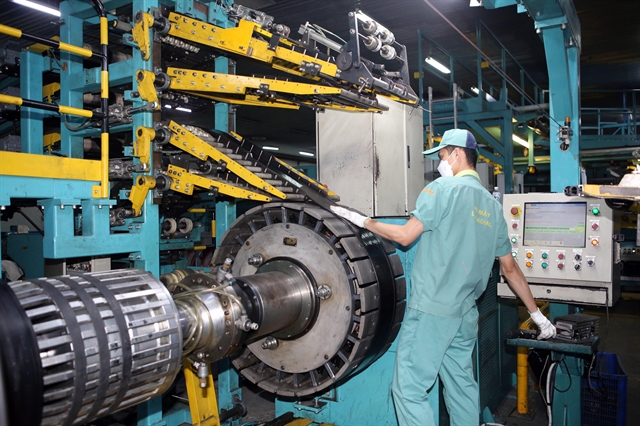| Workers operate the truck tyre production system at the DRC factory in Đà Nẵng City. — VNA/VNS Photo |
HÀ NỘI — The recent decline in natural rubber prices, typically seen as a positive signal for the tyre industry due to reduced input costs, has not brought the expected improvement in profitability.
Instead, several major players in the sector continued to post weaker earnings in the first quarter of this year, largely due to pressure from rising fixed costs and export challenges.
In the first quarter of 2025, Đà Nẵng Rubber Joint Stock Company (DRC) reported a 21.2 per cent rise in revenue to VNĐ1.19 trillion (US$45 million). However, its post-tax profit plunged by 80.8 per cent to only VNĐ9.47 billion, while gross profit margin dropped sharply from 16.6 per cent to 11.1 per cent.
Meanwhile, Casumina (CSM) saw revenue fall by 11 per cent to VNĐ1.02 trillion, with pre-tax profit declining by 25.9 per cent to VNĐ17.48 billion.
The primary reason behind the decline in rubber prices is the high inventory levels in China amid weakening demand for automobiles and electric vehicles in that market. However, cheaper input materials have proven insufficient to offset the headwinds faced by tyre companies, particularly those heavily reliant on exports and burdened by increasing fixed costs.
DRC currently depends on exports for nearly 70 per cent of its revenue, with the US and Brazil being its key markets. The company has reported consecutive profit declines since 2022 and is now attempting to expand into Europe, the Middle East and Africa. Nevertheless, profit margins in these new markets remain modest.
On top of that, DRC has been under added cost pressure since it launched phase III of its radial tyre plant in the second quarter of 2024. Its outstanding debt surged from VNĐ573.8 billion in 2021 to VNĐ1.07 trillion by the end of Q1/2025, equivalent to 55.9 per cent of its equity.
Casumina also continues to face low capital and asset efficiency compared to the industry average. In 2024, the firm posted a net profit of VNĐ72.07 billion, but its return on assets reached just 1.87 per cent, far below the industry average of 5.59 per cent. Its return on equity stood at 5.37 per cent, compared to the average of 12.8 per cent.
For 2025, the company has set a revenue target of VNĐ4.7 trillion, a 5 per cent decrease, and expects profit to rise modestly by 6 per cent to over VNĐ94 billion. With ongoing uncertainty in export markets, Casumina is now pinning its hopes on domestic market growth.
Although input prices may continue to fall, this does not guarantee an imminent recovery for the tyre industry. Market access barriers, rising fixed costs and low operational efficiency remain major hurdles that industry players must overcome in order to regain a path of sustainable growth. — VNS
